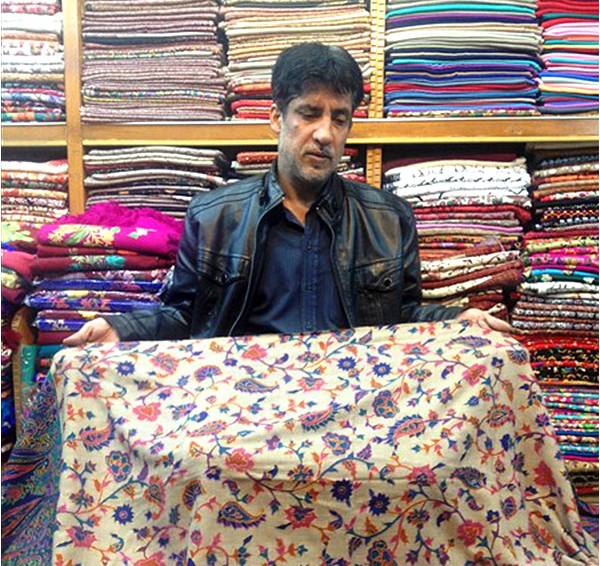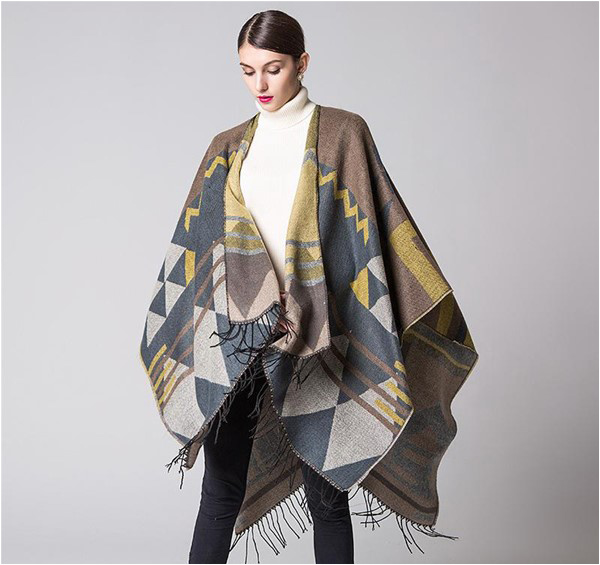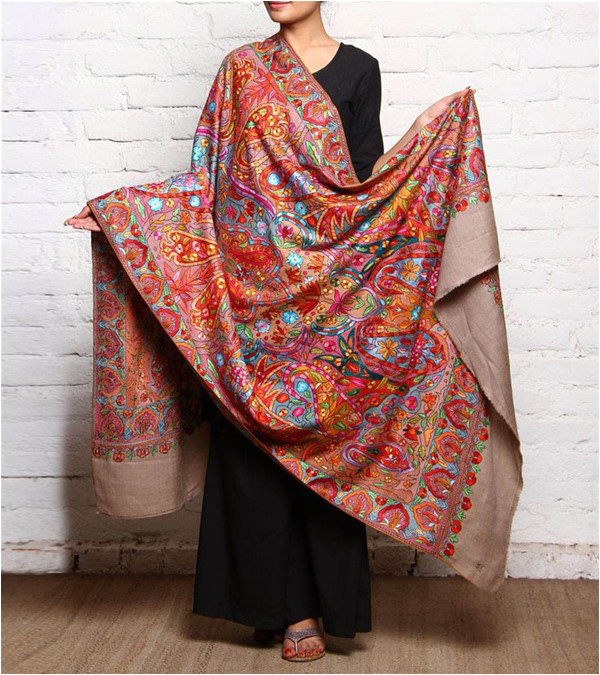
The state of Jammu and Kashmir enjoys global recognition for its works of art and crafts. Traveling, even in the remotest parts of the state, shows that the region had been a great centre of embroidery since the time of the ancient Silk Route. The knowledge and expertise which the Kashmiri people today enjoy dates back to those times gone by.
I had already mentioned in my feature in The Friday Times (titled “Appreciating the Kashmiri Kulcha”) that there is no replacement available throughout the world for two of Kashmir’s products: the handmade Srinagar shawls and the Kulchas of Muzaffarabad, Azad Kashmir. I tried to establish in my previous piece that this was so for the Kulcha as an item of food. I now hope to speak of the other item mentioned there: the shawl!

Historically there is an interesting link, when it comes to the shawls and the famed ‘Pashmina’, between Kashmir and Hamadan in modern-day Iran. A UNESCO report from 2014 mentions that Cashmere crafts were introduced by Sayyid Ali Hamadani who came to Ladakh, homeland of Pashmina goats. There he found that the Ladakhi Kashmiri goats produced very soft wool. He took some of this goat wool and made socks, which he presented as a gift to the ruler of Kashmir, Sultan Qutub-ud-din. Afterwards Hamadani suggested to the Sultan that they start a shawl weaving industry in Kashmir using this wool. And that is how the Pashmina shawls began!
Further, according to UNESCO, Sayyid Ali Hamadani was one of the principal historical figures who shaped the culture of Kashmir as we today know it: whether we speak of architecture or the flourishing of arts and crafts – in essence, the very economy of Kashmir. The skills and knowledge that he brought to Kashmir in weaving shawls gave rise to an entire industry.
With the passage of time, through innovation and its compatibility with Western fashion, the Kashmiri shawl got global recognition for the features that distinguish it. The embroidery work and extravagant designs became the ultimate choice for women in West and East alike.
There are generally three types of fibres used in the making of the shawl: shahtoosh, Pashmina and wool. And for the decoration they are embroidered in Sozni, or with various motifs as embroidery. Pure Pashmina is quite expensive – which in turn makes shawls manufactured from it expensive – but if mixed, the cost can be controlled. Shahtoosh is known for its lightness and warmth but is now listed among banned items – since the Tibetan Antelope from which the fibres come is an endangered species.
The Fashion Encyclopedia, while mentioning Kashmiri shawls, reports that Kashmiri textiles began flooding European markets in the seventeenth century. It provided the foundation for the great popularity of Kashmir shawls among fashionable European women in the late eighteenth and early nineteenth centuries. Despite the high price of these shawls, we are told, the demand increased rapidly among European women. Recognising the potential for profit, European textile manufacturers began to make imitation Kashmir shawls in factories located throughout Europe.
Madame Emile Gaudin, a Greek lady and a reigning beauty, is reputed to have first worn a Kashmiri shawl in Paris. The Empress Josephine was not very far behind: her love of these shawls was second only to her love of flowers, we are told
Today, female visitors to the central markets of the capital city of Azad Kashmir, Muzaffarabad, come in search of these famed shawls.

The owner of Srinagar Shawls in Madina Market, Mr. Zubair Butt tells me that quite a large number of tourists from various parts of the country are visiting his shop to purchase these famous Kashmiri shawls.
“They are not only buying for themselves, but for their family and friends as winter gifts. They do become somewhat hesitant after they get to know the price of the original Pashmina shawls but they generally end up taking at least one!”.
Mr. Butt tells me that an exclusive collection of Kashmiri shawls is available with him, the cost of which ranges somewhere from 3 – 5,000 rupees apiece. I am further told that these products are being imported from Srinagar and are beautifully crafted with threads and embroideries according to the most current market trends.
Mahwash Farrukh, a Karachi-based teacher shares her experience of Kashmiri shawls that she bought from Muzaffarabad last year. She says, “Kashmiri shawls were especially demanded by my mother and my mother-in-law when they heard that we are going to Muzaffarabad. Luckily, I got what I was looking for! Kashmiri shawls are much more expensive if you buy them from Karachi, Lahore or Islamabad as compared to Muzaffarabad.”
The joy of these shawls is not just for women. Men, in fact, can equally share in the warmth they provide!
Large, thick and warm Kashmiri shawls for men are available in the market. They form a common accompaniment to menswear in Pakistan, Afghanistan and beyond. Especially at home, it is possible to just wrap it around and enjoy the warmth and comfort that it provides.
Winter in Kashmir is incomplete without the image of everyone wrapped in their own exquisite shawls, sitting around a fireplace.
Mubashar Naqvi is a freelance writer based in Muzaffarabad. He may be reached at mubashar_naqvi@yahoo.com
I had already mentioned in my feature in The Friday Times (titled “Appreciating the Kashmiri Kulcha”) that there is no replacement available throughout the world for two of Kashmir’s products: the handmade Srinagar shawls and the Kulchas of Muzaffarabad, Azad Kashmir. I tried to establish in my previous piece that this was so for the Kulcha as an item of food. I now hope to speak of the other item mentioned there: the shawl!

Historically there is an interesting link, when it comes to the shawls and the famed ‘Pashmina’, between Kashmir and Hamadan in modern-day Iran. A UNESCO report from 2014 mentions that Cashmere crafts were introduced by Sayyid Ali Hamadani who came to Ladakh, homeland of Pashmina goats. There he found that the Ladakhi Kashmiri goats produced very soft wool. He took some of this goat wool and made socks, which he presented as a gift to the ruler of Kashmir, Sultan Qutub-ud-din. Afterwards Hamadani suggested to the Sultan that they start a shawl weaving industry in Kashmir using this wool. And that is how the Pashmina shawls began!
Further, according to UNESCO, Sayyid Ali Hamadani was one of the principal historical figures who shaped the culture of Kashmir as we today know it: whether we speak of architecture or the flourishing of arts and crafts – in essence, the very economy of Kashmir. The skills and knowledge that he brought to Kashmir in weaving shawls gave rise to an entire industry.
Sayyid Ali Hamadani found that the Ladakhi goats produced very soft wool
With the passage of time, through innovation and its compatibility with Western fashion, the Kashmiri shawl got global recognition for the features that distinguish it. The embroidery work and extravagant designs became the ultimate choice for women in West and East alike.
There are generally three types of fibres used in the making of the shawl: shahtoosh, Pashmina and wool. And for the decoration they are embroidered in Sozni, or with various motifs as embroidery. Pure Pashmina is quite expensive – which in turn makes shawls manufactured from it expensive – but if mixed, the cost can be controlled. Shahtoosh is known for its lightness and warmth but is now listed among banned items – since the Tibetan Antelope from which the fibres come is an endangered species.
The Fashion Encyclopedia, while mentioning Kashmiri shawls, reports that Kashmiri textiles began flooding European markets in the seventeenth century. It provided the foundation for the great popularity of Kashmir shawls among fashionable European women in the late eighteenth and early nineteenth centuries. Despite the high price of these shawls, we are told, the demand increased rapidly among European women. Recognising the potential for profit, European textile manufacturers began to make imitation Kashmir shawls in factories located throughout Europe.
Madame Emile Gaudin, a Greek lady and a reigning beauty, is reputed to have first worn a Kashmiri shawl in Paris. The Empress Josephine was not very far behind: her love of these shawls was second only to her love of flowers, we are told
Today, female visitors to the central markets of the capital city of Azad Kashmir, Muzaffarabad, come in search of these famed shawls.

The owner of Srinagar Shawls in Madina Market, Mr. Zubair Butt tells me that quite a large number of tourists from various parts of the country are visiting his shop to purchase these famous Kashmiri shawls.
“They are not only buying for themselves, but for their family and friends as winter gifts. They do become somewhat hesitant after they get to know the price of the original Pashmina shawls but they generally end up taking at least one!”.
Mr. Butt tells me that an exclusive collection of Kashmiri shawls is available with him, the cost of which ranges somewhere from 3 – 5,000 rupees apiece. I am further told that these products are being imported from Srinagar and are beautifully crafted with threads and embroideries according to the most current market trends.
Mahwash Farrukh, a Karachi-based teacher shares her experience of Kashmiri shawls that she bought from Muzaffarabad last year. She says, “Kashmiri shawls were especially demanded by my mother and my mother-in-law when they heard that we are going to Muzaffarabad. Luckily, I got what I was looking for! Kashmiri shawls are much more expensive if you buy them from Karachi, Lahore or Islamabad as compared to Muzaffarabad.”
The joy of these shawls is not just for women. Men, in fact, can equally share in the warmth they provide!
Large, thick and warm Kashmiri shawls for men are available in the market. They form a common accompaniment to menswear in Pakistan, Afghanistan and beyond. Especially at home, it is possible to just wrap it around and enjoy the warmth and comfort that it provides.
Winter in Kashmir is incomplete without the image of everyone wrapped in their own exquisite shawls, sitting around a fireplace.
Mubashar Naqvi is a freelance writer based in Muzaffarabad. He may be reached at mubashar_naqvi@yahoo.com

